Imagine it’s two o’clock in the morning, and one of your customers needs support. Will there be anyone on your team awake to help them? Well, if you’ve got an AI chatbot on your side, then you can rest assured that the answer is yes!
AI chatbots for customer service are available around the clock to ensure every customer is able to receive timely and personalized assistance. With the right AI chatbot development services, your business can deliver a chatbot-powered support experience that ensures every interaction feels smooth and simple for your customers.
Here’s a jaw-dropping fact: the chatbot market growth rate from 2024 to 2028 is 27.7%, which means it could be worth USD 22.4 billion in just a few years. This data shows how fast companies worldwide are adopting artificial intelligence and chatbots to improve customer experience.
Ready to learn how to improve customer experience with a chatbot? Let’s dive into the game-changing capabilities of chatbots, ways to use them, as well as their disadvantages, and how to minimize potential risks.
Article Highlights:
- AI chatbots provide round-the-clock service, reducing the need for a large support team;
- With custom chatbot development, you can utilize customer data to offer tailored recommendations and proactive assistance that drive loyalty and increase conversions;
- CHI Software’s AI chatbot integration with natural language processing (NLP) successfully handles complex customer inquiries, improving the accuracy of responses.
The Benefits of Chatbots in Customer Service
The first question that businesses usually ask is how can chatbots improve customer service, and why do we need one? We are ready to give you our most detailed answers in this chapter.
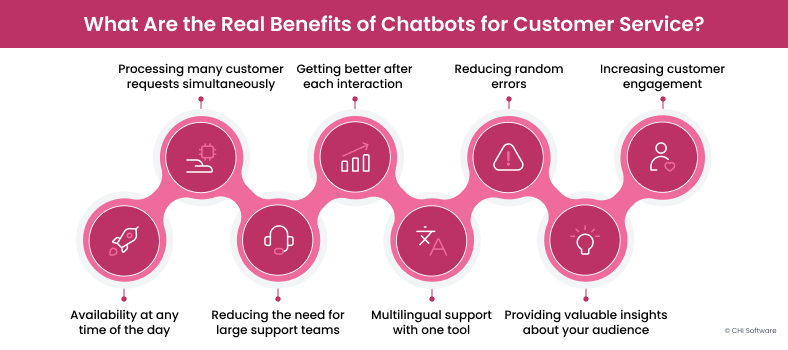
That’s how AI chatbots improve customer experience and transform operations.
1. Chatbots Never Go Offline
AI chatbots provide 24/7 availability, which means your customers will always get support, day or night. This feature is especially critical in e-commerce or travel, where problems can arise outside of business hours. Chatbots stay active and provide constant and immediate assistance, unlike humans who need time to rest.
2. Chatbots Speed Up Work
AI chatbots can process many customer requests simultaneously, handling hundreds or thousands of queries without extra effort. Intelligent tools can retrieve information, provide answers, and help customers solve problems in seconds. Moreover, modern AI chatbots can integrate with CRM systems to optimize processes, meaning the customer never has to repeat a request.
3. Chatbots Are Cost-Effective
Using AI and chatbots for customer experience reduces the need for large support teams, helping businesses save money on salaries, training, and infrastructure. This benefit is backed up by a Gartner study, which predicts that by 2027, chatbots will be the primary customer service channel for about 25% of organizations.
How to Successfully Implement Your First Chatbot?
Read more
4. Chatbots Learn and Improve
AI chatbots use machine learning (ML) to get better with each interaction. Over time, they recognize customer patterns, preferences, and frequently asked questions, allowing chatbots to respond faster and more accurately. Using NLP development services ensures your chatbot can understand even complex language and slang, making interactions more intuitive for users.
5. Chatbots Are Multilingual
Global businesses benefit significantly from AI-driven customer support, as innovative AI chatbots can effortlessly speak multiple languages, ensuring you don’t lose customers due to language barriers.
6.Chatbots Reduce Human Errors
AI chatbots operate based on pre-set algorithms, always following a consistent protocol. For example, a chatbot will never misspell an email address or forget to apply a discount code.
7. Chatbots Offer Valuable Information
Every conversation with a chatbot can be a treasure trove of data. Chatbots track patterns in customer queries, monitor the most common pain points, and analyze trends in real time. But they don’t just collect data – they can turn that data into action.
For example, a chatbot can flag complaints about a feature or product, allowing your team to notice them in time and make changes before the problem gets out of hand and goes global.
8. Chatbots Increase Customer Engagement
AI chatbots make interaction easy, even enjoyable. They can help customers at every stage of their journey, from answering simple questions to recommending products they might like based on their preferences.
Here’s how they do it:
- Personalization: Chatbots remember customer preferences and tailor their responses accordingly;
- Interactive features: Many chatbots use visuals, buttons, even GIFs to make the conversation more vivid and memorable;
- Proactive assistance: Chatbots can be the first to ask a customer ‘do you need help finding something?’ or ‘do you have any questions about this product?’
When customers feel valued and understood, they are more likely to stay with you and recommend your business to others.
Are you ready to join the chatbot business revolution? Let's make it a reality together!
Contact our team
How to Apply AI Chatbots in Customer Service: Use Cases That Work
Below, we will look at eight practical cases of using artificial intelligence chatbots in customer support.
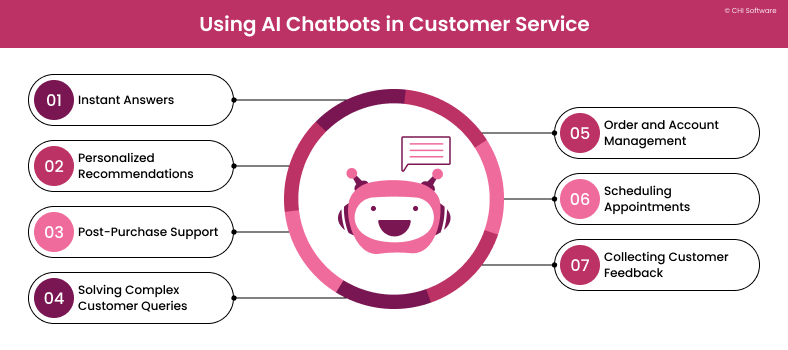
These are go-to scenarios of using AI chatbots in daily business routines.
Instant Answers
No user wants to spend an extra minute on hold, so chatbots are a lifesaver. Chatbots improve customer experience by providing answers to recurring questions such as ‘what is your return policy?’ or ‘how do I reset my password?’.
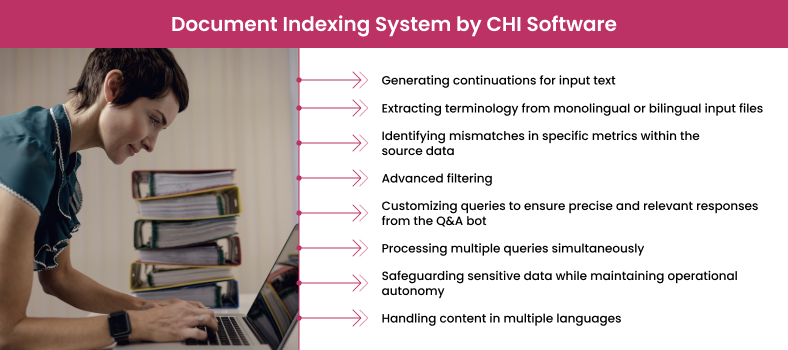
This is a tool developed for the linguistic industry with a goal to automate the most common FAQs.
After CHI Software developed and implemented a document indexing system for one of our US-based clients, they achieved impressive outcomes:
- A 20% increase in efficiency and faster response times by automating query workflows;
- Streamlined operations with an intelligent bot while keeping their web content up-to-date using smart scraping technology.
Order and Account Management
Chatbots can even make account management and order tracking tasks easier. How? Customers are able to quickly ask a chatbot where their order is, or how to initiate a return without waiting on hold.
Does your client need to update their profile? They can forget about those clunky, tedious forms. A chatbot can guide the user through the entire process with just a few clicks and guarantee that every piece of information is always up to date.
And here’s the best part: AI chatbots make users feel special by notifying them about discounts or exclusive privileges, so that they don’t miss out on money-saving offers or feeling their preferences are valued.
Personalized Recommendations
Analyzing user preferences, purchase history, and website usage patterns allows for a high level of personalization. A striking example is a virtual try-on makeup app that provides product recommendations based on skin type and beauty goals.
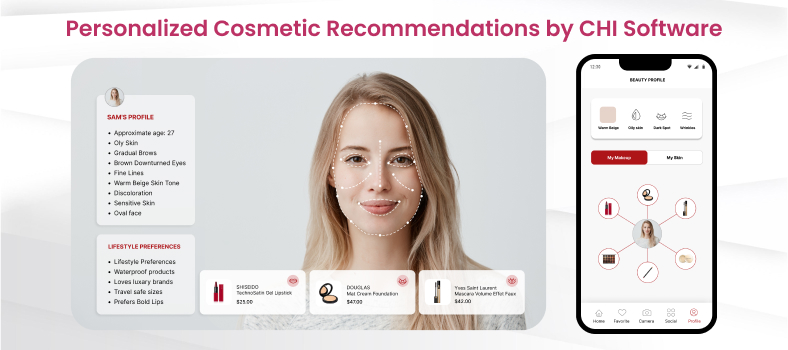
We used generative AI and computer vision algorithms to revolutize online customer support in the beauty industry.
Here’s how it works: users simply upload a photo of their face, and the platform analyzes everything from eye color to skin type using artificial intelligence and machine learning. The chatbot then continues communicating with the customer throughout the purchase process.
Scheduling Appointments
Chatbots take the hassle out of scheduling appointments. Customers need only choose a suitable time slot, since chatbots can take requests even outside business hours and automatically add new appointments to your CRM system. Chatbots can also send timely reminders about a scheduled event: a slight push to keep both sides on track.
If plans change, a single message to the chatbot is sufficient to reschedule the meeting – no need to call customer service or lose time with unnecessary questions.
Solving Complex Customer Queries
Advanced artificial intelligence chatbots equipped with NLP can answer complex questions and understand ambiguous language, redirecting only the unresolved cases to a human agent.
CHI Software created an AI assistant integration for an ERP system and enhanced it with NLP to handle complex customer queries, providing accurate and timely answers. NLP also helps extract and process information from various text formats, including .docx, .pdf, and more.
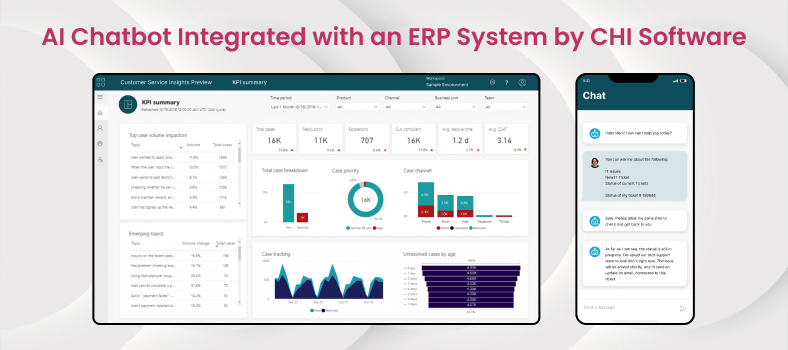
For this project, we developed both a chatbot itself and a user-friendly admin panel to manage the chatbot’s knowledge base.
Post-Purchase Support
Businesses can utilize a chatbot for customer service by providing seamless post-purchase support. For example, AI chatbots for ecommerce can automatically update customers on the status of their orders or walk them through the return process, answer questions about return policies, and even generate return labels – all without the need for human involvement.
Collecting Customer Feedback
After the user interacts with the company, the chatbot asks: ‘How was your experience?’.
Instead of a long survey, the user has a simple choice: click on the star or choose an emoji.
In short, it’s a win-win. For businesses, it’s a gold mine of insights. For customers, it’s a simple and enjoyable way to share their opinions that doesn’t take much time.
Overcoming Challenges of AI Chatbot in CX: CHI Software’s Advice
As a company specializing in custom chatbot development, CHI Software has identified the main challenges you may stumble over during your project. That’s what you can do to make things work.
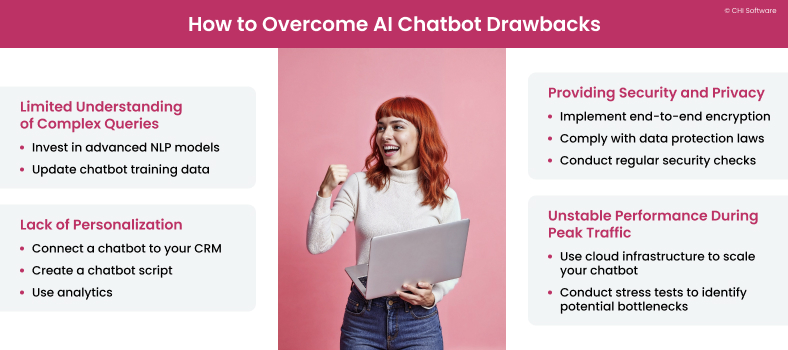
This is how you can minimize possible drawbacks of the AI-driven customer support.
Limited Understanding of Complex Queries
Conversational chatbots sometimes fail to understand complex or ambiguous user requests because of the limited NLP capabilities or insufficient training data. How to address this issue?
- Invest in advanced NLP models to improve understanding. Implement transformational models such as GPT or BERT, which understand ambiguous language well and can analyze words in context, not in isolation;
- Training or refining the model on industry-specific datasets is also a good way to go. For example, if your field is healthcare, train models on medical texts. In finance, use datasets rich in financial terminology and scenarios;
- Regularly update your chatbot’s training data to reflect common user issues and phrases.
Lack of Personalization
Generic responses can make users feel like they’re talking to a robot rather than interacting with a personalized service. AI offers many opportunities to address this issue, such as:
- Connect a chatbot to your CRM system so that chatbots can rely on user profiles to offer personalized recommendations;
- Aim to develop a chatbot that adapts its responses to each user’s behavior during the conversation. To do this, you need to create scenarios with multiple paths. If the user seems unsure, the chatbot can switch to a more explanatory tone and offer additional resources;
- If you have already created successful scripts, you can develop your chatbot with minute-by-minute improvement. ML-powered chatbots can predict customers’ intentions, anticipate what they might need next, and generate responses based on user profiles or previous interactions. For example, if a user frequently asks about discounts, a chatbot can recognize this pattern and share current promotions or offer loyalty programs.
Chatbot Development Pricing Based on Real Cases
Read more
Providing Security and Privacy
With data breaches becoming increasingly common, users are wary of sharing personal information with chatbots. Mishandling data can damage trust and lead to compliance issues.
- Implement end-to-end encryption and make sure your chatbot is compliant with data protection laws, such as GDPR.
- CHI Software emphasizes regular security checks to protect user information and identify vulnerabilities. What does this include? First, simulate cyberattacks to see if the chatbot’s defenses can withstand them. You can also work with cybersecurity experts to independently assess your system.
Unstable Performance During Peak Traffic
High traffic can overload chatbots and lead to slow responses or crashes. There are several tips to prevent such situations:
- Use cloud infrastructure to scale your chatbot. There is a sufficient number of cloud providers such as AWS, Azure, or Google Cloud. Moreover, they have automatic scaling policies that help to regulate computing power;
- Conduct regular stress tests to identify potential bottlenecks. For example, you can use tools like Apache JMeter, Locust, or K6 to simulate the simultaneous interaction of thousands of users with your chatbot.
How AI-Driven Customer Support Changes the Future
AI and chatbots are transforming the customer experience, with their evolving capabilities set to revolutionize customer service.
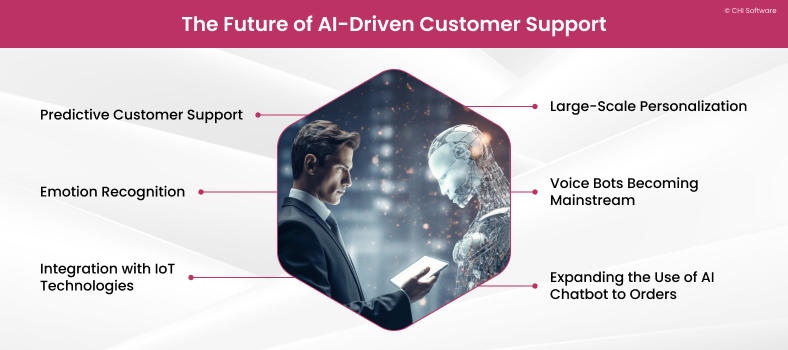
This is how customer support may evolve with AI in upcoming years.
Predictive Customer Support
We expect chatbots to analyze data on past interactions, purchase history, and behavioral patterns, so chatbots can offer proactive solutions.
For example, if a customer bought a laptop in your store 12 months ago, the chatbot will automatically detect the warranty is about to expire and send them a reminder, with options for extending it.
Emotion Recognition
Emotion recognition can make chatbot responses more similar to human interactions. We are sure that future chatbots will be able to sense frustration – not only by the words customers use, but also by how they say them (the tone in their voice messages,) or how fast they type.
If the user’s speech shows frustration – for example, by using capital letters or repeating the same question – the chatbot can connect them with a human agent. If the user expresses satisfaction through positive feedback or emojis, the chatbot can further personalize the conversation with rewards.
Large-Scale Personalization
Large-scale personalization is where generative AI for retail shines. When your customer is shopping for a new phone, instead of bombarding them with countless options, the chatbot asks a few targeted questions:
- “What is your budget?”
- “Do you prioritize a good camera or long battery life?”
The chatbot quickly narrows down users’ choices based on the answers, saving you time and effort.
Knowledge Base Chatbots: Build & Optimize AI Support
Read more
Integration with IoT Technologies
AI bots can easily integrate with new technologies, for example the Internet of Things (IoT). How can this help your customers? For example, an AI chatbot can offer step-by-step visual instructions.
An IoT integration can also monitor the status of a device and proactively alert users when maintenance or troubleshooting is needed. Such support doesn’t just solve problems – it makes technology more straightforward and more accessible to everyone.
Voice Bots Becoming Mainstream
In the near future, customers will be able to securely make payments through chatbots; whether for subscriptions, one-time purchases, or in-app transactions, leading to the ability to complete the ordering process using a chatbot. After a few clicks or a simple confirmation, the chatbot can process a payment and complete the transaction.
Expanding the Use of AI Chatbot to Orders
In the near future, customers will be able to securely make payments through chatbots; whether for subscriptions, one-time purchases, or in-app transactions, which leads to the ability to complete the ordering process with a chatbot.
Conclusion
Chatbots are already making life easier for customers, allowing them to get the help they need in seconds or recommendations based on what they like. And the best part is that chatbots are only going to get better. As artificial intelligence advances, AI chatbots in CX will gain the ability to perform more and more complex tasks, predict customer needs and create experiences that feel less like transactions and more like conversations.
This combination of simplicity and value will position chatbots at the centre of exceptional customer experiences, and continually change how companies communicate with their audiences.
Make chatbots a cornerstone of your customer service strategy today! Reach out today to learn how CHI Software can help your company succeed.
FAQs
-
Will implementing an AI chatbot replace human customer service agents?

Not completely. Chatbots provide timely and personalized support and will significantly reduce your customer service agent costs – but for complex, nuanced, or emotionally sensitive support issues, human agents are still essential.
-
Can AI chatbots support multiple languages?

Yes, AI chatbots can be programmed to support multiple languages. Making use of NLP and machine translation tools, chatbots can understand and respond in various languages. However, the quality of support depends on the chatbot's training and customization for each language.
-
What are the key features to look for in a customer service AI chatbot?

It's important to consider several key features to ensure AI chatbot meets your business needs:
- NLP capabilities: for providing more meaningful and human-like interactions;
- Omni-channel integration: for seamlessly integrating across multiple channels;
- Context awareness: for providing contextually relevant responses and more personalized experience;
- Escalation to human agents: for transfering conversations to a human agent for complex issues;
- Analytics and reporting: for offering insights into customer interactions;
- Scalability: for handling increased traffic without sacrificing performance or quality;
- Integration with existing systems: for integrating with your CRM, databases, and other systems;
- Self-learning and adaptability: for continuous learning from interactions and improving the chatbot’s responses over time.
-
How can businesses measure the success of AI chatbots in customer service?

Success can be measured through:
1. Resolution rate: The percentage of queries the chatbot resolves without human assistance;
2. Response time: How quickly the chatbot addresses customer inquiries;
3. Cost savings: Reduction in operational costs compared to traditional support methods;
4. User feedback: Insights directly from customers about their chatbot experience.
-
How much time and money does it take to build a customer service AI chatbot with CHI Software?

CHI Software offers a tailored approach to ensure your chatbot meets your business goals efficiently, so the time and cost depend on the chatbot's complexity and required features. But here is general information:
- Simple chatbots may take 4-6 weeks, while advanced ones can take 2-3 months.
- Basic customized chatbot solutions start from USD 20,000.
If you would like more information about chatbot development cost, feel free to contact our team.
About the author
Alex is a Data Scientist & ML Engineer with an NLP specialization. He is passionate about AI-related technologies, fond of science, and participated in many international scientific conferences.
Rate this article
21 ratings, average: 4.9 out of 5









